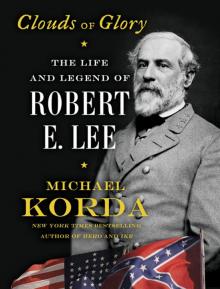- Home
- Michael Korda
With Wings Like Eagles: A History of the Battle of Britain Page 6
With Wings Like Eagles: A History of the Battle of Britain Read online
Page 6
Mitchell and Vickers were eager to put to good use his experience of designing record-breaking monoplanes, but curiously, of the eight fighters built to meet the Air Ministry’s specifications, his Type 224 monoplane, an ungainly all-metal gull-wing aircraft, though innovative, was one of the least successful designs, with a performance inferior to the very conventional biplane that was finally accepted by the RAF, the Gloster Gladiator.* The Type 224 was powered by the Rolls-Royce Goshawk engine, with evaporative cooling built into the leading edges of the wings; test pilots complained that the red warning light signaling an overheating engine came on before they were even off the ground, and ground crews got burned every time they touched the wings after a flight.
Mitchell was not a man who took criticism well, even from test pilots (he was already suffering from colon cancer, which would kill him), but in this case, he seems to have sat down at his drawing board and gone back to the basics willingly enough. In 1934, while the Type 224 was still being flight-tested, he and Vickers undertook to redesign it as a “private venture” (that is, at Vickers’s own expense). Mitchell began by getting rid of the gull wings, making the undercarriage retractable, and enclosing the cockpit, the result being a very modern-looking fighter, with squarish wings and the cockpit rather far forward. He was still stuck with the Goshawk engine and its evaporative cooling system, which he liked because it eliminated the drag of an external radiator. The Air Ministry was interested, but not overly enthusiastic, so Mitchell further refined the design, in which the lines of the Spitfire first begin to appear. The most radical part of Mitchell’s design was its wing spars, made of “square concentric tubes which fitted into each other,” and which were at once lightweight, extremely strong, and very flexible. As a result, the Spitfire’s wings would flex like those of a bird in flight, to the delight or alarm of the pilot, and demonstrating the value of Mitchell’s apprenticeship in locomotive construction, which had given him an instinctive feel for metal.
At this point, another private venture entered the scene: in the Rolls-Royce PV (for private venture) XII, a twelve-cylinder aero engine of twenty-seven liters (to put this in perspective, the largest twelve-cylinder automobile engines produced by Mercedes-Benz and BMW today have a cubic capacity of six liters) intended to produce more than 1,000 horsepower. The Rolls-Royce PV XII was almost “a third heavier than the Goshawk,” so inevitably Mitchell’s design changed. He moved the cockpit farther back to compensate for the added weight of the engine, and made the wing thinner and broader in chord. Working with a very thick, soft lead pencil, he rounded out the lines of his fighter on the drawings provided by his draftsmen, endlessly streamlining it until it began to “look right”: harmonious, balanced, elegant, as his Schneider Trophy planes had been. By January 1935 his wing had achieved the graceful shape that was to make the Spitfire instantly recognizable—the thinnest possible wing that could contain two guns and the retractable undercarriage and its mechanism, perfectly elliptical, without a single straight line. On paper, this design impressed the Air Ministry enough that it wrote a new specification around it—events in Germany, although the British government played them down, were increasing the sense of urgency in the Air Council.
Under Dowding’s aegis a study was undertaken of what it would take to shoot down one of the new all-metal German bombers. The speeds at which aerial combat would now be taking place were calculated, and it was determined that a fighter pilot would have only two seconds in which to fire a burst that would destroy a German bomber. Also, to provide a sufficient “weight of metal” to do the job a fighter plane would require at least six and if possible eight guns of .303 caliber—although only three years earlier, two guns had been considered sufficient. Mitchell was unfazed—his elliptical wing, he said, could carry four guns as easily as two, and he quickly made the necessary alterations, at the same time eliminating the evaporative cooling system in the interests of simplicity. Dowding altered the Air Ministry’s specifications to match those of Supermarine’s new fighter, and in June 1935 the Air Ministry placed an order for the aircraft even though it was still on the drawing board and Fighter Command was still waiting for its Gloster Gladiator biplanes.
On March 5 or 6, 1936 (the log of Vickers’s chief test pilot, Captain “Mutt” Summers, is unclear), the Spitfire prototype made its first flight, and on March 15 Dowding inspected it. It was apparent to everyone that Mitchell had succeeded beyond anybody’s expectations, perhaps including his own. Anxious to gain more speed, and perhaps also moved by pride in his fighter, he asked the Rolls-Royce engineers how they got such a perfect finish on their cars, and they sent painters down from Derby to sand down the prototype, apply numerous coats of blue-gray lacquer, and polish it until it shone like a mirror—or like one of their cars. By July it had demonstrated, in a service trial flight at RAF Martlesham Heath, that it could take off in 235 yards, climb to 25,000 feet in just under eleven minutes, and fly at 350 miles per hour; that it had a ceiling of 30,000 feet; and, most important of all, that it was “simple and easy to fly and has no vices.” Even before that test flight the Air Ministry had ordered 310 aircraft at a total price of £1.395 million (about £4,500 each), excluding guns, radios, instruments, and all other “service equipment,” the largest order ever given for an airplane in Britain to that date.7 The first production Spitfires reached RAF squadrons in 1938, a year after Mitchell’s death from colon cancer at the age of forty-two,* so he never saw the vital role his aircraft would play in Britain’s survival in 1940, but it would not have surprised him.
It had first flown in 1936, the year Hitler reoccupied the Rhineland; and it began to reach service squadrons in 1938, the year of Munich. In the air, at least, the governments of Stanley Baldwin and Neville Chamberlain were better prepared than they have been given credit for—or than the Germans believed at the time.
Perhaps even stranger was the fact that unlike the Germans, the British spread their bets, and built two very different fighters instead of just one. At the same time as the Spitfire was being developed, one of Mitchell’s rivals as an aircraft designer, Sydney Camm of Hawker Aircraft, was designing the Hawker Hurricane. In 1933 Camm, a forceful and energetic man, had tried and failed to interest the Air Ministry in building a high-speed monoplane fighter to replace the aging Hawker Fury biplane he had designed.8 Objections had been raised regarding the weight, cost, and practicality of the Hurricane, but Hawker decided to continue the project as a private venture, and by 1935 the Air Ministry was sufficiently alarmed by the rapid growth of the German aviation industry to place an order with Hawker for a prototype. The Hurricane was easier to build than the Spitfire—Camm used the existing Fury as the starting point for his fighter, with fabric for some of the surface (which also made it quicker and easier for ground crews skilled in the use of fabric, dope, and glue to repair, and reduced the cost), and it would eventually be powered by the same Rolls-Royce Merlin engine as the Spitfire. Camm developed a thick, sturdy wing, in which there was no difficulty finding room for four machine guns and an undercarriage that retracted inward, toward the fuselage, rather than outward, thus giving the Hurricane a notably wide, stable track, unlike the Spitfire, with its dangerously narrow track. (Another benefit of Camm’s robust wing design was that the Hurricane would later adapt easily to carrying four twenty-millimeter cannon and even two forty-millimeter cannon in its role as a “tankbuster” in the Western Desert of North Africa, and to carrying bombs under its wings as a Hurribomber. It could also be flown off carrier decks or fitted with skis for operating in Norway.) The Hurricane took its first flight in 1935, a year before the Spitfire, and it proved to be so easy to fly that when the Hawker test pilot, P. W. S. Bulman, who wore a snappy fedora hat for the flight, stepped out of the cockpit afterward, he turned to Camm and said, “It’s a piece of cake—I could even teach you to fly her in half an hour, Sydney.”9
By 1937, production Hurricanes were reaching RAF squadrons in quantity. Camm would always regret not having design
ed a thinner wing, but no pilot ever complained about that—the Hurricane could absorb enormous punishment and still get you home in one piece; and although it was slower than the Spitfire and had a lower ceiling, its thick wings and the grouping of its guns close together (that roomy wing again!) made it a steadier gun platform. Both aircraft were at least the equal of the Bf 109E in 1939 and 1940, and would remain in production, in updated versions, until 1945. Dowding fussed over the details of both his fighters, as he fussed over the details of everything, finally persuading the Air Ministry, after an epic struggle, to order the manufacturers to put a thick piece of laminated, optically flat, bulletproof glass in front of the pilot in 1939, just in time for the war, and to install hot-air ducting into the wings to keep the breeches of the guns from freezing solid at high altitudes.
With radar in operation, the details of fighter control worked out, and two different types of eight-gun monoplane fighters in service, Dowding had good reason to feel confident that he could meet the enemy on equal terms, if the politicians and the Air Council let him do his job.
CHAPTER 4
“The Other Side of the Hill”
—The Duke of Wellington*
Across the North Sea, in Germany, the Luftwaffe was developing in a very different way, and under a radically different leadership. The contrast between the two air forces was remarkable. The RAF as the junior of the three British services suffered from something of an inferiority complex, which manifested itself in a combination of bravado—an example, later in the war, was Air Chief Marshal Sir Arthur Harris’s stubborn belief that RAF Bomber Command could win the war all by itself, if given the resources—and a prickly relationship between officers and “other ranks,” which Len Deighton captured perfectly in Bomber, and whose spirit pervades T. E. Lawrence’s famous book on the RAF in the early 1920s, The Mint. Because the RAF lacked the ancient regimental traditions and identity that were the backbone of the British Army, and the sense of being shipmates sharing the same risks and dangers that made shipboard discipline in the Royal Navy more tolerable, the gulf between officers and “other ranks” was in some ways wider than in the other services. The fact was that the “other ranks” thought of themselves (and were officially described) as “tradesmen,” unlike soldiers or sailors, and brought with them into the service some of the sullen attitude toward authority of skilled workers and union members in civilian life; while the NCOs in the more specialized trades took on something of the role of union shop stewards in a factory, becoming in effect intermediaries between management and labor. Eight weeks of “square bashing” and polishing his boots were seldom enough to turn a skilled engine mechanic into an obedient soldier-in-blue who accepted the authority of commissioned officers as natural.
A certain respect for pilots (and, to a lesser degree, for aircrew in general) pervaded the RAF, but flying was also a trade. Almost half the pilots in the RAF were NCOs, not officers (in the Battle of Britain 42 percent of the fighter pilots would be sergeants, flight sergeants, or warrant officers), as were many of the navigators, bombardiers, flight engineers, and wireless operators, and all of the air gunners—indeed, it was only the war that put stripes on the sleeves of many of these men, partly because flying duties made their mealtimes erratic and the sergeants’ mess was better suited to flexible mealtimes, and partly because RAF aircrew would be afforded better treatment by the enemy as sergeants if they became prisoners of war.
Traces of old-fashioned class-consciousness pervaded the organization of the RAF, despite the fact that it was the most “modern” and technologically minded of the three services. An example was the so-called Auxiliary squadrons. In order to permit rapid expansion in the event of war, the RAF relied on three separate and distinctly different schemes. The first was the RAF Reserve, consisting of regular officers who had retired from the service, or had completed their term of service (“short-term” commissions were then for four years). The second consisted of the Royal Auxiliary Air Force squadrons, intended to be the equivalent of the army’s “Territorials,” many formed by adventuresome aviation enthusiasts. One of the earliest of such squadrons, No. 601 (County of London) Auxiliary Air Force Squadron, based at RAF Tangmere, had been founded in the bar at White’s Club in 1924 by Lord Edward Grosvenor, a son of the fabulously rich duke of Westminster; its pilots were predominantly wealthy City stockbrokers and wine merchants, and it quickly became known as the “millionaires’ squadron.” The No. 615 (County of Surrey) Auxiliary Air Force Squadron was almost as exclusive, and furthermore had as its Honorary Air Commodore Winston Churchill; and the Oxford University Air Squadron was equally glamorous. Typically, one of No. 601 Squadron’s pilots was W. M. L. “Billy” Fiske, a wealthy and social young American sportsman, who won a gold medal on the U.S. bobsled team at the 1932 Winter Olympics in Lake Placid, married the former countess of Warwick, had an international reputation as a skier and golfer, drove a British Racing Green 4.5-liter super-charged Bentley, and on August 16, 1940, became the first American in the Royal Air Force to be killed in combat in World War II.1 The Auxiliary squadrons brought to RAF Fighter Command an additional element of dash and high spirits, symbolized by such customs as officers leaving the top button of the tunic open and wearing a brightly patterned silk scarf loosely knotted around the neck, habits of dress that were not always appreciated by RAF Station Commanders, and that soon spread to non-Auxiliary pilots, even to a few sergeant-pilots. The third element, the RAF Voluntary Reserve, was less elitist and less flamboyant, being a more ambitious nationwide training scheme for aircraftmen. At the beginning of the war, members of the Royal Auxiliary Air Force wore a small brass A on the lapels of their tunic, whereas the members of RAF Volunteer Reserve who were commissioned wore a small brass V, but by the end of 1940 these distinctions were no longer encouraged, or widely observed.
Thus, the Royal Air Force, as it formed for war, was a typically British combination of professionals and amateurs, with an equally typical British concern for class differences—certainly a little less stuffy, at least among the pilots and aircrew, than the more elite infantry and cavalry regiments of the British Army, and a lot less sure of its place than the Royal Navy, but still a recognizably British institution.
The enemy it would face was organized along very different lines, and on the surface, at least, seemed more powerful and more “modern.” Forbidden to maintain a military aviation industry under the Treaty of Versailles, Germany had begun systematically evading that restriction early in the 1920s, long before the Nazi Party came to power. General Hans von Seeckt, the austere commander of the Reichswehr, was a strong believer in an independent air force; he encouraged the widespread formation of “glider clubs” for German youth; funneled subsidies to the German aircraft industry to design “civil” aircraft that could be adapted or rapidly converted into military ones; made the new German airline, Lufthansa, a clandestine means for teaching young men destined for military aviation to fly; and arranged for those who succeeded to receive advanced training secretly in Soviet Russia. When Hitler became chancellor in January 1933, the foundations had already been laid not only for a modern aviation industry but also for a nationwide scheme for training young people as pilots. All that was necessary was to put a Nazi gloss on what already existed, and pour money secretly into building up-to-date military aircraft. Although Göring’s outsize faults were even then clear enough, nobody could deny his energy, his flair for publicity, or his lack of scruples in achieving his ambitions on the largest possible scale; as Hitler’s air minister (among his many other offices) he worked hard and cut through every bureaucratic difficulty to make Germany a formidable air power overnight. One consequence was that propaganda about Germany’s air power created widespread alarm long before it was in fact a realistic threat; but by 1935, when the existence of the Luftwaffe was officially acknowledged by Hitler—Göring was himself the first to display its new uniform, which, despite his bulk, he modeled proudly for his pilots, who were themselves the
n still dressed in the modest uniform of civilian airline pilots—the infrastructure of a major air force was already complete.
It was, as it would necessarily have been, an air force that satisfied the Führer, who at this stage was more interested in bluff than in war. Hitler remained throughout his life an ex-soldier—airplanes (and warships) did not interest him as intensely as artillery and tanks. About guns and tanks he could never have too much detailed information, and his opinions, though those of a layman, were often perfectly sensible, despite his taste for the outsize and even the gigantic. On the subject of airplanes he seldom interfered, and when he did he was often wrong. Certainly in the 1930s he was willing to leave it all in the hands of Göring. What Hitler wanted was an air force that would overawe and frighten other nations. Bombers interested him more than fighters—he saw no likelihood that Germany would need to be defended from air attacks—and the more bombers, the better. “Strategic” bombing, as it later came to be known, did not much interest him, either. The Luftwaffe was primarily intended from the beginning to intimidate Germany’s neighbors, and if intimidation failed, to serve as a major weapon, airborne artillery, for supporting the German army in the event that Hitler’s aims could not be won by diplomacy and threats.

 Passing
Passing Another Life
Another Life Clouds of Glory
Clouds of Glory Hero: The Life and Legend of Lawrence of Arabia
Hero: The Life and Legend of Lawrence of Arabia Cat People
Cat People Hero
Hero With Wings Like Eagles: A History of the Battle of Britain
With Wings Like Eagles: A History of the Battle of Britain Ulysses S. Grant
Ulysses S. Grant